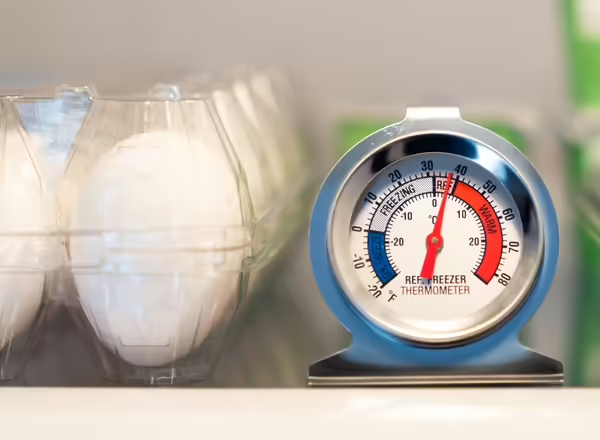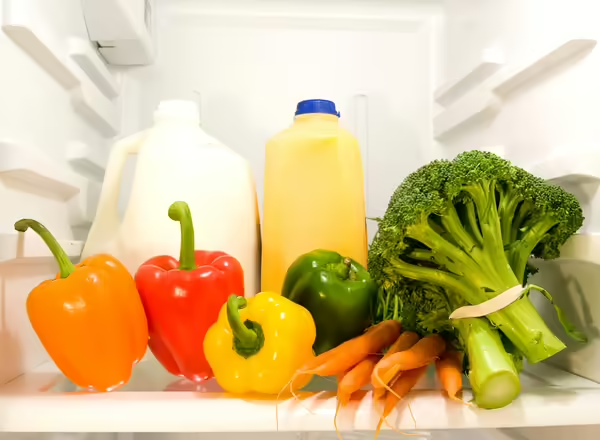Title
Storing Food
Many foods can be stored safetly at room temperature. However, if food was refrigerated or frozen at the store, it is generally best to keep it in a similar environment at home, unless you are preparing to cook it right away or thaw it for cooking within a safe timeframe. Some shelf stable foods will need to be refrigerated once opened — always read the package for recommendations.
Food Package Dates
Dates indicated on food packages can help both retailers and consumers manage their food supplies safely. Some dates relate to the safety of the product, while others can help indicate when food is at peak quality. Learn about different food package dates to help avoid unnecessary food waste, save money, and ensure best practices for food quality and safety.
Sell By or Pull Date
This date indicates when stores must remove products. Food will be safe to eat after this date if it has been refrigerated. Dairy products will usually be edible at least one week longer than the sell-by date. Eggs will be kept for 3 to 5 weeks after the listed date. Foods that use sell-by or pull dates include milk, yogurt, cottage cheese, cream, eggs, lunchmeats, and packaged salad mixes.
Best If Used By Date
This date is a recommendation to consumers when the product’s flavor or quality is highest. It is not a purchase or safety date.
Pack Dates
This date, typically found on canned foods, crackers, cookies, and spices, indicates the date the product was packaged. Manufacturers and retailers use it to track inventory, rotate stock, and locate items in the event of a recall. Since each manufacturer may use its own dating system, it can be hard for consumers to interpret the date.
- Packages of food will be safe for long periods after the pack date, but may not be as flavorful.
- Canned foods will be safe but may have changes in taste and texture for many years after this date.
- If the container has bulges or dents, throw it away.
- Any product with a broken seal or “off” smell should not be eaten.
Use By Date
This is the last date recommended to ensure a product’s peak quality. The manufacturer of the product has determined the date.
Expiration Date
Expiration dates are printed on infant formula, baby food, vitamins, over-the-counter drugs, yeast, baking powder, cake mixes, and pectin.
- Expires 2/15/27
- Do not use after 2/15/26
Infant formula, baby food, and over-the-counter drugs should never be consumed after the expiration date because they may not function in the body as initially intended. Leavening agents like yeast will be safe but may not be as effective after this date. The same applies to baking mixes and pectin used for jams and jellies.
Quality Assurance Date
It is best if foods with a long shelf life are used before expiration, but they may begin to lose flavor or develop off-flavors. The date indicated estimates how long the food will be of optimum quality. Quality is defined as odor, taste, and texture; it is not a measure of safety.
If the product smells or tastes bad or the seal on the package has been broken, don’t use it. Packaged food mixes, such as macaroni and cheese, boxed soups, bakery products, cheese, some canned foods, cold cereals, peanut butter, and mayonnaise often use this date stamp.
Room Temperature Storage
Many foods can be stored safely at room temperature. A reminder that perishable foods should not be kept at room temperature for longer than 2 hours. Examples of foods that can be stored safely at room temperature include:
Uncooked rice, grains, lentils, legumes
Uncut produce like whole onions, potatoes, and sweet potatoes
Baking staples, like flour and sugar

Tips for Storing Pantry Foods
- Keep the food storage area dry.
- Keep food off the ground.
- Do not store food and cleaning supplies in the same area.
- Cover opened food with a storage bag or place in a storage container with a lid to prevent pests from getting into the food.
- Do not use food in swollen cans; this is a sign that Clostridium botulinum could be growing inside, producing toxins that will make you sick when consumed.
- Rotate pantry foods using the “First in First Out” method to maximize quality and reduce food waste.
Cold Storage
Keep cooled foods safe by storing them in appropriate temperatures as quickly as possible – and do not let perishable food stay at room temperature for more than two hours. The two-hour safety window starts as soon as frozen, raw, or refrigerated food is taken from a cold grocery shelf, refrigerator, freezer, or cooler. Transport time counts too!

Store raw meats, poultry, eggs, cut fruits and vegetables, pasteurized milk, and pasteurized juice below 40 F in a refrigerator. Do not overcrowd the refrigerator — allow space for air to circulate around each food item. Clean the refrigerator often to prevent the accumulation of harmful bacteria, such as Listeria monocytogenes, that can grow in cold temperatures.
- Freeze refrigerated food within a few days.
- Use freezer-safe packaging.
- Use freezer containers 2 to 3 inches deep to maintain quality and prevent ice crystals from forming.
- Check temperatures with a thermometer intended for refrigerators and freezers.

Minimize the chance of cross-contamination between foods by keeping certain types of foods on specific shelves in the refrigerator.
- Never store raw vegetables on the same shelf as raw meat.
- Store less perishable foods, such as condiments like mustard, pickles, jellies, and ketchup, in the door, which is often warmer than other parts of the refrigerator. These have added protection, including high sugar or high acidity, to limit harmful bacteria from growing.
- Use crisper drawers for fruits and vegetables and drawers or bin intended for meats and cheese as intended.
- Follow additional recommendations below as closely as possible, depending on how many shelves are available.
| Refrigerator Placement | Types of Food |
|---|---|
| Top Shelf | Ready-to-eat foods; foods that will not be heated (milk, juices, beverages, cheese, raw vegetables) |
| Second Shelf | Cooked foods that will be reheated before eating (casseroles, leftover cooked food) |
| Third Shelf | Raw fish and raw steak |
| Fourth Shelf | Ground meat (raw eggs may be stored on the same shelf) |
| Fifth Shelf | Poultry (raw eggs may be stored on the same shelf) |
| Door | Condiments (ketchup, mustard, pickles, jellies, etc.) |
Preserve Food by Freezing!
Steps for Freezing Produce
Wash and Drain
Wash and drain produce before removing cores, pits, seeds, and skins. Wash small amounts at a time, change the water several times, and do not let the produce soak. This will prevent harmful bacteria from entering the produce tissues through the natural openings.
Fruits: Choose Packing Type
For fruits, determine how to prevent discoloration, if needed, and select your packing type. Most fruits have a better texture and flavor if packed in sugar or syrup.
Vegetables: Blanch and Cool
For vegetables, follow appropriate blanching times and cool quickly by plunging into cold ice water, then drain. Blanching is to scald vegetables in boiling water or steam for a short time.
Package and Label
Pack food in freezer-safe containers. Food expands when frozen; be sure to leave sufficient space between the top of the packed food and the closure of the container to allow for that expansion. Label the container with the product name and the current date. Freeze at 0 F or below and use within 8 to 12 months for the best quality.
Freezer Food Types and Storage Times
Many foods can be frozen successfully, but some may lose quality when exposed to extreme cold temperatures. Find out what food you can freeze, and for how long, to maximize its quality.
Baked Goods
Freezing does not refresh baked goods; it can only maintain whatever the quality of the food was before freezing.
| Food | Recommended Storage Time for Top Quality at 0 F. |
|---|---|
| Yeast Bread and Roll Dough (unbaked) | 1 month |
| Yeast Bread and Rolls (baked) | 2 to 3 months |
| Quick Bread and Muffins (baked) | 2 to 3 months |
| Cake Batter | 1 month |
| Baked Cake (unfrosted) | 2 to 4 months |
| Baked Cake (frosted) | 1 month |
| Angel Food Cake | 6 to 12 months |
| Chiffon Sponge Cake | 1 to 2 months |
| Fruit Cake | 6 to 12 months |
| Cookies (baked at home) | 8 to 12 months |
| Cookies (commercially packaged) | 8 to 12 months |
| Cookie Dough (unbaked) | 3 months |
| Fruit Pies and Pastries (baked) | 1 to 2 months |
| Fruit Pies and Pastries (unbaked) | 2 to 4 months |
| Cream Pies and Pastries | 3 months |
| Pancake and Waffle Batter | 3 months |
Dairy
| Food | Recommended Storage Time for Top Quality at 0 F. |
|---|---|
| Butter or Margarine | 12 months |
| Cheese Hard): Cheddar, Swiss, etc. | 4 to 6 months. Shred or slice into smaller pieces before freezing for best results. |
| Cheese (Processed): Loaves, Slices | 4 to 6 months |
| Cheese (Soft): Brie, Cottage | Does not freeze well. |
| Cream (Heavy) | 2 to 4 months. Lighter cream and half-and-half do not freeze well |
| Ice Cream and Sherbet | 2 months |
| Milk | 3 months. Place into smaller airtight containers and leave an inch at the top to allow it to expand. |
| Yogurt | 1 to 2 months |
Eggs
Eggs can be stored in the refrigerator for at least one month. To store longer, crack eggs and mix the yolks with the whites. To prevent graininess, add 1 Tablespoon of sugar or ½ teaspoon salt per one cup of egg mixture. Strain through a colander to improve uniformity. Leave an inch of empty space (headspace) at the top of the container. Do not freeze eggs in the shell.
| Food | Recommended Storage Time for Top Quality at 0 F. |
|---|---|
| Eggs in the Shell | Do not freeze. |
| Whole Eggs Out of the Shell | 12 months |
| Egg Substitutes (unopened) | 12 months If opened, do not freeze. |
Fish
For best quality, double wrap.
| Food | Recommended Storage Time for Top Quality at 0 F. |
|---|---|
| Cooked, Commercially Frozen Seafood | 3 months |
| Lean Fish: Cod, Flounder, Haddock, Sole, Trout, Polluck, Perch | 6 months |
| Fatty Fish: Mackerel, Bluefish, Salmon, Tuna, Smelt | 2 to 3 months |
| Shellfish | 3 months |
Fruit
Find additional information about freezing fruits on Extension's Food Preservation website.
| Food | Recommended Storage Time for Top Quality at 0 F. |
|---|---|
| Berries, Cherries, Peaches, Pears, Pineapple | 9 to 12 months |
| Fruit Juice Concentrates | 8 to 12 months |
| Citrus Fruits | 4 to 6 months |
Meat: Beef, Pork, Veal, Lamb, and Wild Game
Check for holes in trays and plastic wrap of fresh meat. Rewrap if needed. For best quality, double wrap.
| Food | Recommended Storage Time for Top Quality at 0 F. |
|---|---|
| Bacon | 1 to 2 months |
| Canned Meat (marked “Keep Refrigerated”) | Do not freeze. |
| Chops: Beef, Lamb, Pork, or Veal | 4 to 6 months |
| Corned Beef | 1 month, drained |
| Frankfurters | 1 to 2 months. Freeze in original packaging. |
| Ground Meat (uncooked) | Overwrap if storing longer than 2 months. |
| Ham (vacuum-sealed, whole, half, or sliced) | 1 to 2 months |
| Luncheon Meats | 1 to 2 months. Product may “weep” when defrosted. |
| Roasts: Beef, Lamb, Pork, or Veal | 6 to 12 months |
| Sausage (fresh, unsalted, or smoked) | 1 to 2 months |
| Steaks: Beef, Lamb, Pork, or Veal | 6 to 12 months |
Poultry: Chicken, Duck, and Turkey
For best quality, double wrap.
| Food | Recommended Storage Time for Top Quality at 0 F. |
|---|---|
| Whole or cut up | 12 months |
| Livers or Giblets | 3 to 4 months |
| Cooked Poultry | 4 to 6 months |
| Chicken Nuggets and Patties | 1 to 3 months |
Main Dishes
| Food | Recommended Storage Time for Top Quality at 0 F. |
|---|---|
| Casseroles and Pie (with Meat, Fish, or Poultry) | 2 to 4 months |
| Commercially Frozen Meals/TV Dinners | 3 to 4 months |
| Soups and Stews | 2 to 4 months |
| Pre-stuffed Pork, Lamb, Chicken, Beef | Do not freeze. |
Other Food Staples
| Food | Recommended Storage Time for Top Quality at 0 F. |
|---|---|
| Bread | 3 months; freeze commercial or homemade bread in a heavy-duty freezer bag. |
| Coconut (shredded) | 1 year |
| Herbs | 1 to 2 years |
| Nuts (unsalted) | 9 to 12 months |
| Nuts (salted) | 6 to 8 months |
| Popcorn (unpopped) | 2 to 3 years |
| Rice (uncooked) | 6 months |
| Spices (ground) | 1 to 2 years |
| Spices (whole) | 2 to 3 years |
Vegetables
| Food | Recommended Storage Time for Top Quality at 0 F. |
|---|---|
| Commercially Frozen | 8 months |
| Frozen Fresh (at home) | 8 months |
Thawing Frozen Foods
Follow safe practices for thawing frozen food. Improper thawing can create an environment where bacteria can grow and multiply quicky on the food, leading to an increased chance of foodborne illness.

Have More Food Storage Questions?
Check out USDA's FoodKeeper resource for a comprehensive list of refrigeration and freezer recommendations for a wide variety of foods and beverages. The resources is also available as the FoodKeeper App on both Android and Apple devices!